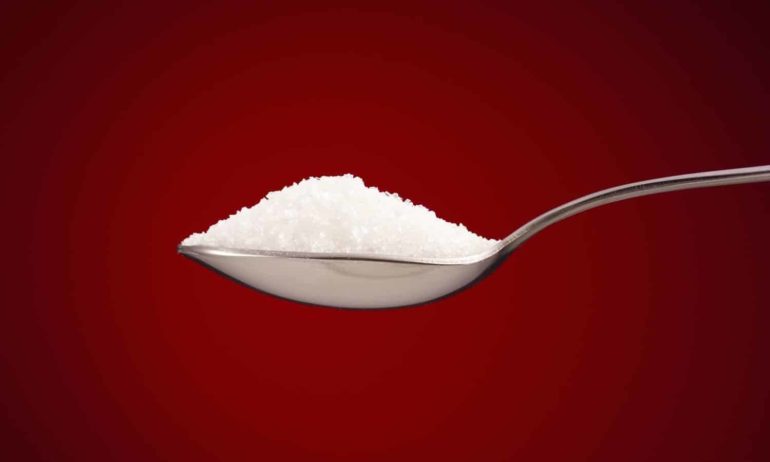In February 2015, the Dietary Guidelines Advisory Committee (DGAC) released a much anticipated report outlining the latest scientific evidence for what Americans should be eating to stay healthy. The DGAC is an independent body of experts tasked with reviewing the research and making recommendations to the U.S. Departments of Agriculture (USDA) and Health and Human Services (HHS) as these agencies develop the 2015 Dietary Guidelines for Americans.
When it came to added sugar, the DGAC found consistent evidence for a causal relationship between sugar consumption and weight gain and between sugar consumption and the rise in the incidence of the major chronic metabolic diseases (e.g. type 2 diabetes, cardiovascular disease, high triglycerides, and hypertension). The report recommends limiting added sugar to 10 percent of daily calories (about 6 teaspoons for women and 9 for men) and labeling added sugars on a line separate from total sugars in grams and teaspoons, as well as the percent daily value, on the Nutrition Facts panel.
Will the USDA and HHS implement these recommendations in the 2015 Dietary Guidelines to be finalized later this year? Pushback from the food industry so far suggests the agencies may face an uphill battle. But if they can resist attacks on the science, the spread of misinformation, and attempts to undermine evidence-based policy making, it would mean a real victory for public health.
The ubiquity of added sugar and why it’s a problem
As ordinary Americans, foodies, and health food junkies alike will attest, sugar marks the special moments in our lives—birthday cake, Christmas cookies, Halloween candy. That’s as it should be. And given the DGAC’s recommendation that a healthy diet can accommodate a small amount of added sugar as a source of discretionary calories, the occasional cookie or slice of cake isn’t going to make anyone sick. It isn’t these special moments we need to worry about.
The problem is that sugar isn’t just found in treats. An estimated 74 percent of packaged foods contain some form of added sugar, and many of these products are marketed as healthy. Soda and other sugar-sweetened beverages constitute a significant percentage of the added sugar we consume, but cereal, yogurt, bread, salad dressing, pasta sauce, granola bars, and many other deceptively healthy foods also contribute to our overconsumption.
What’s the result? Most of us eat far more added sugar every day than experts recommend—19.5 teaspoons per day and a whopping 29.9 kilograms (66 pounds) per year! What that means, frightfully, is that instead of a once-a-year indulgence, every day is like Halloween. Even infant and toddler food contains too much sugar. And all this extra sugar is making us sick. Today, 16 million Americans suffer from heart disease, and 25.8 million are afflicted with diabetes. Approximately 31 percent of adults and 13 percent of children also have a condition called nonalcoholic fatty liver disease, which is associated with metabolic syndrome and which can progress to nonalcoholic liver cirrhosis, a life-threatening condition that requires a transplant.

Why the food industry opposes limiting and labeling added sugar and what they’re doing to influence policy
Despite the presence of added sugar in an overwhelming variety of foods and beverages, the food industry would very much like Americans to think our overconsumption has resulted from our own choices. They add sugar because we like it, they say. But if our excessive sugar intake were merely about personal choices, there would be no debate over recommended limits and package labels. Indeed, to the contrary, if more Americans recognized how much sugar they were consuming and the surprising array of products it was coming from, they might choose to eat less, no matter how good it tasted.
And this is what the food industry has feared for a long time. More than a decade ago, the Sugar Association—a trade group representing sugar interests—went so far as to threaten the World Health Organization when it released a report recommending a 10 percent daily limit on calorie intake from added sugar. Those familiar with WHO history have described sugar industry pressure as “tantamount to blackmail and worse than any pressure exerted by the tobacco lobby.”
Today, food industry trade groups like the Grocery Manufacturers Association (GMA) and the American Beverage Association (ABA), along with some of their member companies, have been working aggressively behind the scenes to attack the science, spread misinformation, and undermine policies. In letters to the DGAC, when the committee’s preliminary findings were known but before the report’s release, they have disputed the DGAC’s thoroughness, asserted that the DGAC was acting improperly, and accused the DGAC, falsely, of taking a stand at odds with public health organizations like the American Heart Association. They have also encouraged the committee to give weight to the insights of scientists with serious conflicts of interest.
In the face of this pressure to put profits over public health, we should applaud the DGAC for standing up for the growing body of scientific evidence that overconsumption of added sugar is a major contributing factor to the increased risk of developing metabolic syndrome, along with the subsequent and significant health care costs of treating it.
Now it is up to the agencies to decide whether and to what degree to implement the DGAC’s science-based recommendations. With a new public comment period open and a public hearing on March 24, the pressure will, no doubt, continue to mount. However, by standing firm and following the science on added sugar, the USDA and HHS could have a significant impact on turning the tide against the food-related chronic diseases affecting American families and communities across the nation—and ultimately achieve a milestone toward protecting our nation’s future health and well-being.















